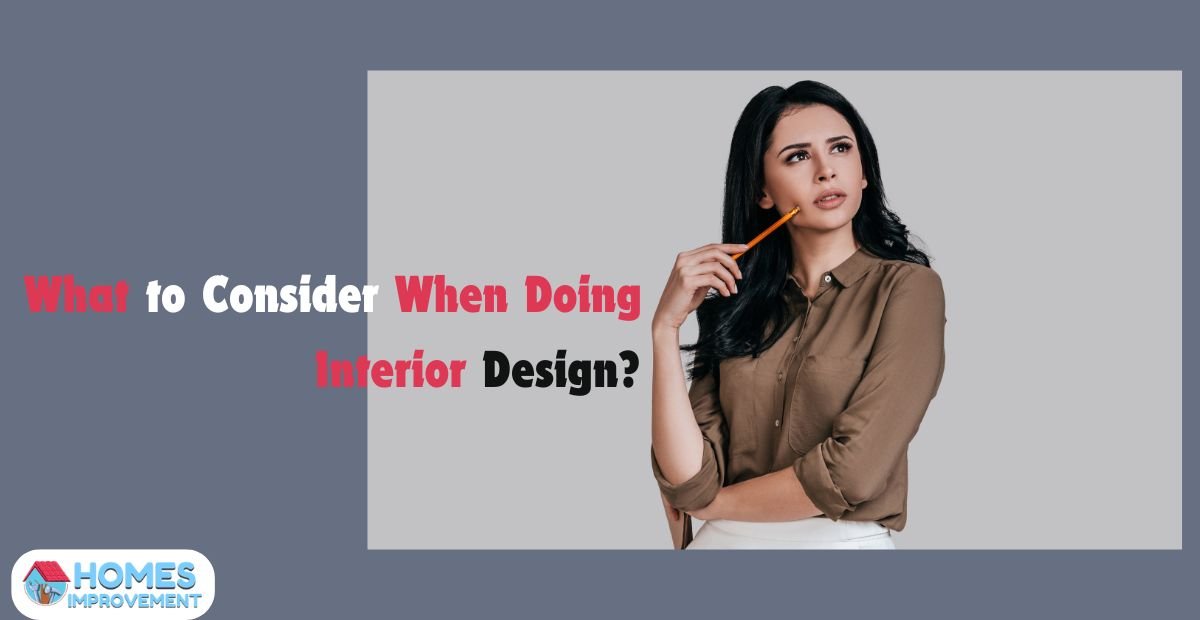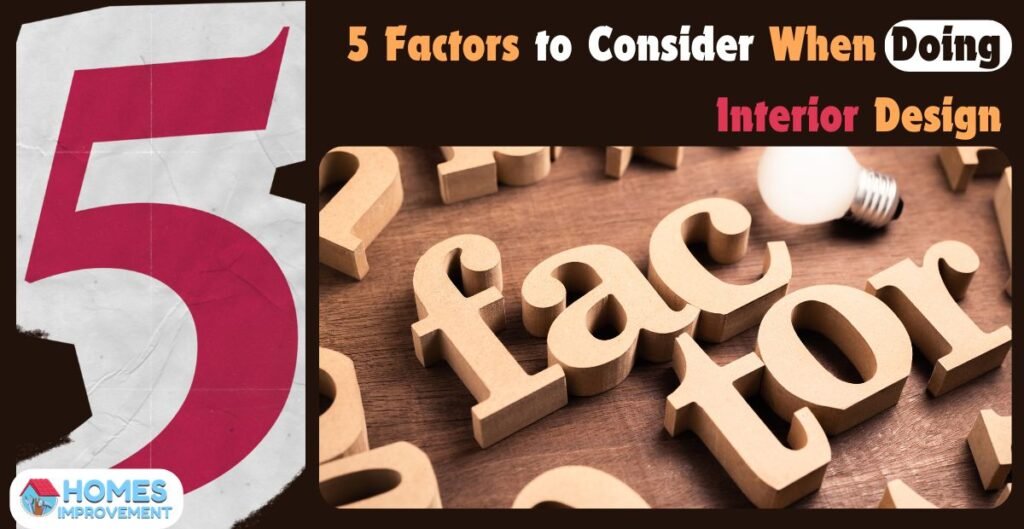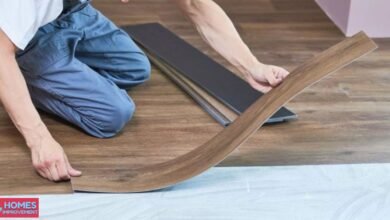What to Consider When Doing Interior Design?

Several important interior design thoughts must be considered to create a beautiful and functional space that prioritizes your style and the atmosphere you want to make in the room.
Consider the layout and how the furniture will fit to make the most of the available space. Lighting is another vital element that may meaningfully change a space’s look and feel.
Furthermore, pick materials and colors that complement the room’s design and future use.
By keeping these factors in mind, you may create a pleasant and helpful room while expressing your personality.
In this guide, we will learn ”What to Consider When Doing Interior Design? ”
5 Factors to Consider When Doing Interior Design (What to Consider When Doing Interior Design?)

Understanding the Space
Assessing the Dimensions and Layout
A vital first step in any design process is measuring the area. Knowing the amount of room you have available helps you select the right furniture and décor. Furthermore, take note of any architectural features, counting windows and doors, as these could impact how your room is organized.
Determining the Purpose of Each Room
Every space has a purpose, whether it’s for sleeping, cooking, or soothing. Think about the events that take place there and how you and your family make use of it. This will assist you in selecting furniture placement, resulting in a unified flow that improves everyone’s quality of life and eases daily living.
Establishing a Design Style
Researching Different Design Aesthetics
Before beginning any interior design job, it’s important to investigate several design styles, such as contemporary, traditional, and modern. Select a design that appeals to you by taking the time to classify each with a unique look and feel. While it’s a good idea to keep up with current trends, choosing a look that perfectly captures your style is even more crucial. In this approach, you’ll build an environment that brings you joy and a sense of home.
Creating a Mood Board
A mood board is an excellent tool for visualizing your design concepts. It functions similarly to a collage, where you can compile images, themes, hues, and things that motivate you. By assembling these parts, you can choose what works best for your space and see how they function as a whole. This fun, creative process can guide your choices and ensure your design style combines beautifully.
Color Selection
Selecting the appropriate colors is crucial for your home design to be comfortable.
Choosing a Cohesive Color Scheme
Knowing color theory can assist you in choosing complementary colors. This entails understanding which hues conflict and which colors go well together, such as blue and yellow. Take into account the lighting in the space as well; natural light can alter a color’s entrance throughout the day.
Remember the scale of the space: brighter hues can elongate a tiny space, while darker hues can draw attention to the focal point of the space.
Using Colour Strategically
When painting, you may paint an accent wall a contrasting color to highlight a particular feature, such as a fireplace. As an alternative, for a unified appearance, paint the entire space one color. Keep in mind that hues can also influence how you feel; for instance, blues are tranquil, while yellows are lively. Carefully selecting your color scheme can create a room that seems exactly right for you.
Furniture and Layout
Selecting Appropriate Furniture
It’s crucial to consider furniture size and available space while selecting. Using the appropriate scale and proportion, your room can appear balanced and welcoming. A giant sofa, for instance, could overpower a small space, while little chairs might look out of place in a large one. Functionality and comfort should also be considered; furniture shouldn’t just look nice; it should also be comfortable and helpful for everyday use. A couch that feels nice to sit on and provides enough seating for everyone is a great choice.
Planning the Arrangement
Arranging your furniture is equally important. Selecting attention-grabbing features like a giant window or fireplace is an excellent place to start. Next, arrange the room so that people may move around it freely and without running into any furnishings. Space optimization is also essential; make good use of your space to prevent clutter. You can design a layout that meets your demands and is both hospitable and functional by carefully arranging your furniture.
Lighting Considerations
Natural vs. Artificial Lighting
Making the most of natural light can make your home feel lighter and cozier. Mirrors, skylights, and large windows can all reflect sunlight and make a space feel happier. However, artificial lighting is also significant; you can employ a variety of it. Task lighting provides general illumination for activities like cooking or reading, ambient lighting highlights architectural features or artwork, and accent lighting brings attention to specific locations.
Layering Light Sources for Versatility
Layering light sources adds many lighting fixtures to a single place to enhance its appearance and functionality. By controlling the brightness of the lights with the help of dimmers and adjustable fixtures, you can create the perfect atmosphere for any occasion. You can add interest and flexibility by combining different lamps and overhead lighting to ensure that your area is well-lit while still feeling warm.
Conclusion
And last, creating an interior space may be rewarding and pleasurable. By considering the foundations of the space, choosing a suitable design style, choosing the right colors, and carefully arranging the furnishings, you can create a room that appears just right for you. Remember to consider lighting and how it affects the mood in your space. Your home may be a cozy, well-designed area that expresses your individuality through creative and intelligent design. Thus, go slowly and relish giving your room a personal touch!
FAQs
What is the first step in interior design?
First, determine the purpose of each place. How you and your family use the space will determine how you arrange the furniture and choose the décor.
How can I find my design style?
Researching several design styles and making a mood board can facilitate finding your personal aesthetic. This will guarantee that the style you’ve selected represents your individual tastes.
What is necessary for interior designing?
Having a clear idea of your area and its purpose is critical while doing interior design. You’ll need a solid grasp of color theory, furniture alternatives, and design ideas. You can also realize your ideas with simple equipment like mood boards, design software, or sketching supplies.
What do you need to know about interior design?
The ability to design places that are both visually beautiful and useful is a necessary component of interior design knowledge. This entails being aware of various design philosophies, the effects of color and light, choosing furniture, and the significance of space layout. Keeping up with modern trends and timeless design concepts is also beneficial.
What are the main points of interior design?
The three main principles of interior design are utility, harmony, and aesthetics. It is vital to confirm that the space is not only visually appealing but also securely meets the needs of its users. The arrangement of furniture and the harmony of colors and textures are vital components of a unified design.
What things do interior designers need?
Interior designers usually require a wide range of tools and resources, such as design software for layout planning, practical communication skills for client concept sharing, and a strong sense of creativity. They must also comprehend interior building laws and regulations and the possibilities for furnishings and materials.




